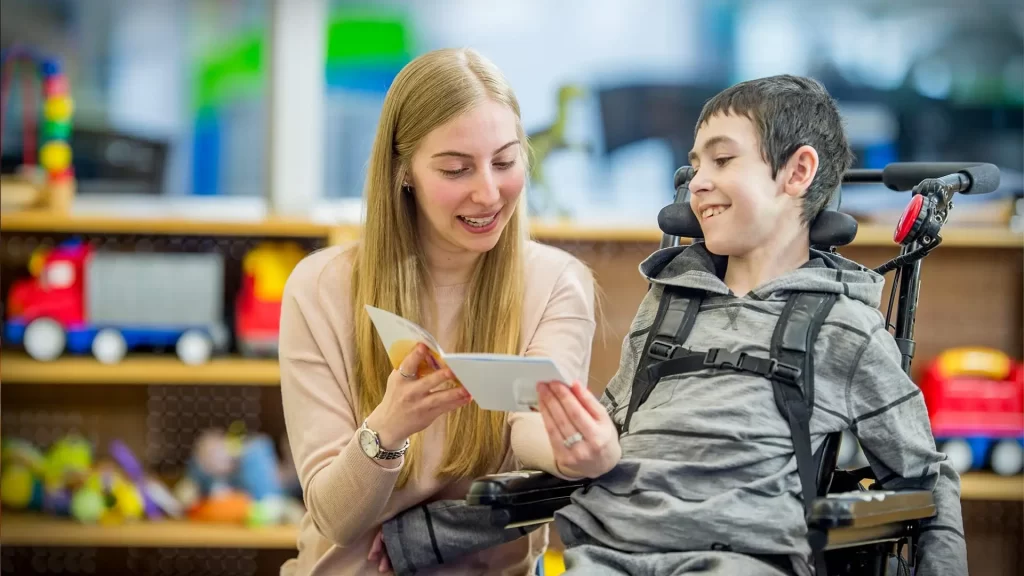As a special education teacher, you are no doubt aware of the importance of finding effective instructional materials, as they can be vital tools for fostering learning among diverse student populations. Understanding how to identify and utilize appropriate materials is crucial in order to ensure that your students are successful in their educational journey. In this blog post, we will offer guidance on what to look for and our top tips when sourcing instruction materials specifically designed for students with additional needs or disabilities. From differentiated tasks that engage multiple learners at once through to access technology enablement options, discover more about optimizing teaching aids today for tomorrows success!
Research Instructional Materials That Have Been Used In Other Schools
Researching instructional materials that have been used in other schools and finding effective instructional materials for special education can be a difficult but necessary task. Educators must assess the effectiveness of these materials to ensure that students are achieving their highest potential. Researching what has been used in other schools could provide an insight into new strategies, updated trends, and real-world applications.

Many different types of instructional materials can be used to support special education students in their learning journey. Some examples include textbooks, worksheets, multimedia tools such as videos or apps, and manipulatives. Textbooks and worksheets should be chosen carefully according to the student’s grade level and specific learning needs. Multimedia tools can also provide valuable learning opportunities by incorporating audio-visual elements into the lessons. Manipulatives can help foster problem-solving skills by allowing students to physically interact with objects while they are learning new concepts.
When researching which instructional materials have been used in other schools, educators should consider the age of the students being taught as well as their individual needs.
Visit Local Library Agencies
Visiting a local library is one of the best ways to find effective instructional materials for special education. Libraries offer a vast selection of books and other resources specifically designed for people with special needs, including those on the autism spectrum, learning disabilities, and physical disabilities. Libraries also provide access to specialized websites, magazines, and other resources.
When searching for instructional materials for special education, it can be helpful to talk to a librarian about what is available in the library’s collection. A librarian can recommend books that are appropriate for special needs learners and direct patrons to online databases containing information that is tailored to meet their individual needs. In addition, librarians can assist patrons in locating materials in other libraries or online if they are not available at the local library.
In addition to providing material specifically designed for individuals with special needs or learning disabilities, many libraries offer workshops and classes specifically geared toward helping parents or educators learn how to better support students with special needs.
How To Use Visuals Effectively In Instructional Materials
Using visuals in instructional materials can provide students with greater understanding and engagement in their lessons. Visuals, like images, diagrams, charts, graphs and videos, can help to bring a lesson to life by providing concrete examples of concepts that may otherwise be difficult for students to grasp. By utilizing visuals in instruction, teachers can make learning more interesting and engaging for their students.
When using visuals in instructional materials, it is important to consider the type of visual that best suits the subject matter being taught. For example, when teaching a science lesson on cells, diagrams of cell structure may be most helpful while a lecture on American history may be better suited for an image of George Washington crossing the Delaware River. Additionally, visuals should be chosen that are appropriate for the age group of the student being taught; pictures of cartoon characters may not interest older students but may appeal to younger learners.
Finding effective instructional materials for special education is particularly important as these types of materials may need to be tailored specifically for each student’s needs.
How To Create Effective Lesson Plans
Creating effective lesson plans and finding effective instructional materials for special education can be challenging tasks. It is important to recognize the unique needs of students with special educational needs or disabilities (SEND) when preparing lessons and materials. To ensure that SEND learners are adequately supported, teachers must take into account the individual needs of each student as well as their own professional experience in creating effective lesson plans.
When planning a lesson, the most important thing to consider is the objective. What is it that the students should learn or gain from the lesson? How will they demonstrate evidence of their learning? How will they be assessed? Once these questions have been answered, teachers can begin to plan their lesson accordingly.
In addition to considering objectives, teachers must also think about how best to teach material so that it resonates with SEND learners. This includes taking into account unique learning styles and abilities, as well as providing additional support where needed. Structuring activities around multiple learning strategies ensures that all students can access and engage with content in meaningful and appropriate ways.
Ask Teachers And Staff Members Who Are Experienced In Special Education
Finding effective instructional materials for special education can be a tricky and time consuming task, especially for those new to the field. Ask teachers and staff members who are experienced in special education can be a great way to start your search. They have the experience, knowledge and resources to help you find the right material for you or your student’s needs.
First, consider the type of disability or learning difficulty the student has. Depending on their individual needs, certain materials may be more effective than others. Ask experienced teachers and staff members what materials they recommend based on their own experiences with students with similar disabilities or learning difficulties. Ask them which specific materials they have found most successful in helping students reach their education goals and objectives.
Keep in mind that some instructional materials may not be appropriate for all learning styles or levels of ability. Ask experienced teachers and staff members if they recommend any particular modifications for certain activities or strategies which might make them more suitable or beneficial for your student with special needs.
Consider Using Interactive Or Multimedia Materialssuch As Videos Or Games
The Consider Using Interactive Or Multimedia Materialssuch As Videos Or Games Finding Effective Instructional Materials For Special Education is an important task for educators. This can help ensure that students with special needs are receiving the best possible instruction and support they need to learn, grow, and reach their full potential.
Interactive or multimedia instructional materials can be particularly effective when it comes to teaching students with special needs. The use of interactive or multimedia materials allows educators to customize the content to meet the needs of each student’s individual learning style and level of ability. By incorporating visuals, sound, animation, and interactivity into lessons and activities, these materials can help students stay focused and engaged in their learning tasks. Additionally, it enables teachers to provide more comprehensive instruction in a shorter period of time by connecting concepts from different areas of study which might otherwise seem separate or disconnected.
For example, imagine a middle school science lesson on photosynthesis that includes a digital video presentation with animated graphics showing the process at work in nature.
Look At The Common Core Standards
The Common Core State Standards (CCSS) are a set of educational standards developed by the National Governors Association and adopted by 45 states and territories in the United States. The CCSS focus on ensuring that all students acquire the skills and knowledge needed to be college- and career-ready. For special education students, the CCSS provide an important framework to ensure that these students are receiving appropriate instruction.
Finding effective instructional materials for special education can be challenging due to the diverse needs of these students. To best serve special education learners, educators must select materials that align with the CCSS while taking into account each student’s unique needs. When selecting materials, teachers should consider whether they are age-appropriate, engaging, and accessible to all students. Additionally, it is important to review materials for accuracy and alignment with applicable state standards.
When choosing effective instructional materials for special education, teachers should look for those that have been designed specifically for special education classrooms. Such materials should include content that is presented at varying levels of complexity to accommodate different learners. In addition, when selecting classroom resources such as textbooks or worksheets, teachers should ensure that they are inclusive of all backgrounds and cultures in order to create an environment where every student feels safe and supported.
Finally, it is important for teachers to involve parents and other stakeholders when selecting instructional materials for special education students in order to identify any potential barriers or challenges specific to a particular student or group of students. This may involve surveying families about their experiences with certain resources or discussing ways to make materials more engaging for particular groups of learners.
In summary, Look At The Common Core Standards provides an important framework for finding effective instructional materials for special education classrooms; however, it is important for educators to also take into consideration individual student needs when making selections. By understanding each student’s unique learning style as well as involving parents in the selection process, teachers can ensure that they are providing their students with meaningful learning experiences tailored specifically towards their own development needs.
Review Online Resources
Reviewing online resources to find effective instructional materials for special education can be a daunting task. With the vast array of options available, it is important to understand the specific needs of each individual child and how they may benefit from certain instructional materials. Different types of materials are available that are tailored specifically to the various types of disabilities and learning styles associated with special education students.
It is essential to consider whether or not an instructional material will help meet the individual needs of a student. It is also important to ensure that both teachers and students are comfortable with the chosen material. Reviewing reviews from other teachers who have used the material may provide further insight into whether or not it is suitable for your students’ needs.
When searching for instructional materials, you should also be aware of any safety concerns or sensitivities that may be present in such a classroom setting. This includes making sure any technology used in the classroom has accessibility features and is appropriate for a student’s physical abilities.
How To Provide Appropriate Resources For Your Students
Providing appropriate resources for your students and finding effective instructional materials for special education can be a daunting and challenging task. However, with the correct strategies in place, educators can ensure that their students have all the support they need to succeed.
The first step towards providing appropriate resources and finding effective instructional materials for special education is to identify the individual needs of each student. This means taking an individualized approach to instruction by understanding each student’s unique learning profile and how best to meet their individual needs. Knowing the differences between learners with different levels of ability will help inform instruction in a way that meets each student’s specific needs.Once the individual needs are identified, it’s important to research curriculum options and instructional materials that match those needs. For example, if a student has difficulty reading or writing, then selecting educational materials that focus on those areas would be beneficial. Additionally, considering the format of these materials is essential; books may be helpful for some students while videos or interactive lessons might prove more effective for others.
What Are Common Special Education Needs?
Common Special Education Needs
Special education needs, or SEN, refer to the difficulties a child may have in grasping some basic skills due to their physical, cognitive, sensory, or learning disabilities. Each child with special needs will have an individualized educational plan based on their strengths and challenges. These plans include modifications to the curriculum to ensure that the child has the right level of instruction and access to the mainstream classroom.
Examples of common special needs include speech and language delays, motor impairments such as cerebral palsy, intellectual disabilities such as Down Syndrome, autism spectrum disorders, developmental delays such as global developmental delay (GDD), hearing impairments such as auditory processing disorder (APD), visual impairments such as retinitis pigmentosa (RP) and dyslexia. It is important for teachers to understand each student’s individual needs and make appropriate accommodations for them in order for them to maximize their potential.
Finding Effective Instructional Materials For Special Education
Instructional materials play an important role in helping students with special needs achieve their goals.
What Are Effective Teaching Techniques?
When it comes to teaching, there are many different techniques that can be employed to ensure that students get the most out of their learning experience. What are effective teaching techniques? What works best for special education? The answers to these questions vary depending on a variety of factors, but there are some basic principles and best practices that help make all teaching techniques more effective.
One important thing to consider is the individual needs of each student. Every student will have different needs and learning styles, which is why one-size-fits-all approaches may not work as well in the classroom. A teacher should be able to understand and accommodate each student’s individual needs in order to create an effective learning environment. This means taking into account both cognitive styles (how an individual processes information) and learning preferences (which methods they prefer). By tailoring instruction according to these preferences, teachers can ensure the material sticks better with their students.
Teachers should also focus on providing meaning context for their instruction.
How To Find And Evaluate Instructional Materials
Finding effective instructional materials for special education is an important part of teaching. Special educators need to be able to find and evaluate instructional materials that meet the needs of their students. When searching for appropriate materials, it’s important to consider the individual learning styles and needs of the student, as well as the subject matter being taught.
When searching for instructional materials, it is important to start by thinking about the goals of instruction and the specific objectives that must be met by the material. Teachers should also think about what type of learner they are dealing with and choose materials based on that learner’s style, strengths, weaknesses and interests.
A good place to begin when looking for instructional materials is online resources such as teacher resource websites or special education-specific websites. Here you can find a range of resources, including digital content, videos, worksheets, activities and other types of resources that could be used in instruction. It’s important to remember that these are just starting points – ultimately teachers must evaluate each individual resource and decide if it’s appropriate for their classroom and student population.
When evaluating instructional materials, teachers should consider things such as how relevant it is to their curriculum; how engaging it will be for students; whether there’s enough variety; whether it allows room for creativity; if there are any potential pitfalls or complexities; how easy/difficult it will be to implement; etc.
In addition to evaluating individual materials teachers also need to consider other factors such as accessibility issues (i.e., will all students be able to access these resources?), budget constraints (how expensive is this resource?) and availability (can I get my hands on this resource quickly?).
Finally, teachers should keep track of all the instructional materials they use in order to measure progress over time. They can do this by keeping a log or portfolio of all the materials they use in instruction which can provide valuable insight into which strategies work best with particular students or topics. This information can then be used by both special education teachers and general education teachers alike when designing future lessons or units.
As a result of the research and analysis, it is evident that there are instructional materials available to meet the needs of all students but more specifically those with disabilities. However, not all instructional materials are effective for every student or meet all academic standards. When searching for instructional materials it is important to consider several factors such as: content, format, delivery method, level of support provided, and overall quality. In addition, parents and educators should work together to ensure that the selected materials Goldborg & Ehrenberg (2018).
Good Video



